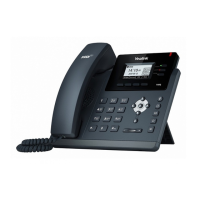Phone Provisioning
89
Example: Deploying Phones from the Provisioning
Server
After setting up your provisioning server(s), you can deploy your phone devices. The following example
shows you how to use the boot and configuration files to deploy phones from the provisioning server.
Procedure
1. Create per-phone boot file and common boot file.
For example, 001565b09d886.boot and y000000000000.boot.
2. Create per-phone configuration files or common configuration files, and edit the feature parameters
in the file you want to apply to the phones. For example,
Custom configuration file:
CustomSettings.cfg
phone_setting.contrast = 7
local_time.time_format = 1
static.lang.gui = Chinese_S
[T42S,T41S]voice_mail.number.1 = *5
[T27G]account.1.dnd.enable = 1
[T41S]account.1.dnd.enable = 0
[T42S]features.dnd.enable = 0
Custom configuration file:
Linekey.cfg
linekey.2.type=13
linekey.2.line=1
linekey.2.value = 4603
linekey.2.label=Bill
MAC-Oriented configuration files:
001565b09d886.cfg
account.1.enable = 1
account.1.label = Bill
account.1.display_name = 1023
account.1.auth_name = 1023
account.1.user_name = 1023
account.1.password = 1023
account.1.sip_server.1.address = 10.2.1.199
account.1.sip_server.1.port = 5060
3. Place the configuration files to the home directory of the provisioning server. For example, D:\TFTP
Provision.
4. Specify the configuration files paths in the boot file as desired. For example,
include:config<tftp:/10.2.5.193/CustomSettings.cfg>
[T46S,T48S]include:config “tftp:/10.2.5.193/Linekey.cfg”
include:config<tftp:/10.2.5.193/Linekey.cfg>
include:config<tftp:/10.2.5.193/001565b09d886.cfg>
5. Place the boot files to the home directory of the provisioning server. For example, D:\TFTP Provision.
6. Reboot IP phones to trigger auto provisioning.

